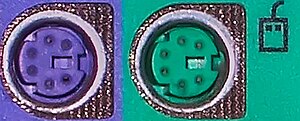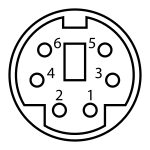PS/2 port
 The color-coded PS/2 connection ports (purple for keyboards and green for mice) | |||
| Type | Keyboard and computer mouse data connector | ||
|---|---|---|---|
| Production history | |||
| Designer | IBM | ||
| Designed | 1987 | ||
| Superseded | DIN connector and DE-9 connector | ||
| Superseded by | Universal Serial Bus | ||
| General specifications | |||
| Pins | 6 | ||
| Connector | Mini-DIN | ||
| Data | |||
| Data signal | Serial data at 10 to 16 kHz with 1 stop bit, 1 start bit, 1 parity bit (odd) | ||
| Pinout | |||
 | |||
| Female connector from the front | |||
| Pin 1 | +DATA | Data | |
| Pin 2 | Not connected | Not connected* | |
| Pin 3 | GND | Ground | |
| Pin 4 | Vcc | +5 V DC at 100 mA | |
| Pin 5 | +CLK | Clock | |
| Pin 6 | Not connected | Not connected** | |
| |||
The PS/2 connector is used for connecting some keyboards and mice to a PC compatible computer system. Its name comes from the IBM Personal System/2 series of personal computers, with which it was introduced in 1987. The PS/2 mouse connector generally replaced the older DE-9 RS-232 "serial mouse" connector, while the keyboard connector replaced the larger 5-pin DIN used in the IBM PC/AT design. The keyboard and mouse interfaces are electrically similar with the main difference being that open collector outputs are required on both ends of the keyboard interface to allow bidirectional communication. If a PS/2 mouse is connected to a PS/2 keyboard port (or if a PS/2 keyboard is connected to a PS/2 mouse port), the mouse (or keyboard) may not be recognized by the computer depending on configuration.
Port availability
In the 386 and 486 era, the connectors were also seen on some PC clones with non-standard case designs and the PS/2 mouse connector was sometimes seen on a separate backplate on systems using a standard AT case. However PS/2 ports only became the norm much later with the introduction of the ATX form factor during the Pentium era (1993-1997). The design decision for identical but incompatible connectors would prove aggravating to consumers. To help alleviate this, PS/2 keyboard and mouse connectors were later color-coded: purple for keyboards and green for mice as defined by the Microsoft PC 97 standard.
Old laptops generally have a single port that supports either a keyboard or a mouse. Sometimes the port also allows one of the devices to be connected to the two normally unused pins in the connector to allow both to be connected at once through a special splitter cable. This configuration is common on IBM/Lenovo Thinkpad notebooks. The mouse interface is somewhat different from RS-232 (which was generally used for mice on PCs without PS/2 ports) but nonetheless many mice were made that could operate on both with a simple wiring adapter.
PS/2 mouse and keyboard connectors have also been used in non-PC compatible computer systems, such as the DEC AlphaStation line, early IBM RS/6000 CHRP machines and SGI Indy, Indigo 2, and newer (Octane etc.) computers.[1]
Today's laptops frequently do not include PS/2 ports and so the port is now regarded as a legacy port on Wintel, having been superseded by USB. Many current keyboards and mice support both USB and PS/2 with a simple wiring adapter and active adapters are available which plug into a USB port and provide a pair of PS/2 ports. PS/2 ports however, can still be found on modern desktop computer motherboards, although some newer motherboards have no PS/2-port or only the keyboard port. These PS/2 ports cause less problems when KVM switching with non-Wintel systems.
Color code
Original PS/2 connectors were black. Later PC 97 color code was introduced. PC 97 made the keyboard port, and the plugs on compliant keyboards, purple; mouse ports and plugs were green. As of 2007, this code is still used on most PCs, however the ports are exactly the same and therefore can be switched without issues.
| Color | Description | |
|---|---|---|
| Purple | Keyboard | |
| Green | Mouse | |
Hardware issues
PS/2 ports are designed to connect the digital I/O lines of the microcontroller in the external device directly to the digital lines of the microcontroller on the motherboard. They are not designed to be hot swappable. Hot swapping PS/2 devices usually does not cause damage due to the fact that more modern microcontrollers tend to have more robust I/O lines built into them which are harder to damage; however, hot swapping can still potentially cause damage on older machines, or machines with less robust port implementations.
If they are hotswapped, the devices must be similar enough that the driver running on the host system recognizes, and can be used with the new device. Otherwise, the new device will not function properly. While this is seldom an issue with standard keyboard devices, the host system rarely recognizes the new device attached to the PS/2 mouse port.
PS/2 connectors are not designed to be plugged in and out very often, which can easily lead to bent or broken pins.
As noted, in a standard implementation both PS/2 ports are usually controlled by a single microcontroller on the motherboard. This makes design and manufacturing extremely simple and cheap. However, a rare side effect of this design is that a malfunctioning device can cause the controller to become confused, resulting in both devices acting erractically. The resulting problems can be difficult to troubleshoot (e.g. a bad mouse can cause problems that appear to be the fault of the keyboard).
See also
References
- ^ Lenerz, Gerhard (7 November 2006). "Common Input Devices". Hardware. SGIstuff. Retrieved 2007-03-14.
{{cite web}}: Check date values in:|date=(help)
